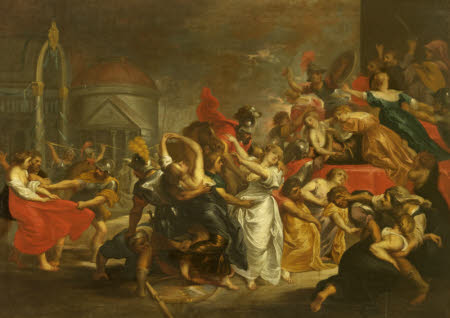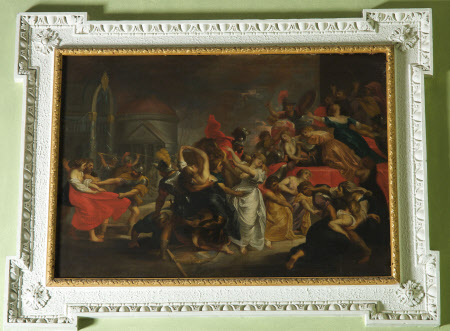The Rape of the Sabines
Victor Wolfvoet II (Antwerp 1612 - Antwerp 1652)
Category
Art / Oil paintings
Date
1600 - 1699
Materials
Oil on canvas
Measurements
819 x 1156 mm (32¼ x 45½ in)
Place of origin
Antwerp
Order this imageCollection
Lacock, Wiltshire
NT 996274
Caption
In order to ensure the growth of the population of Rome, Romulus organized a festival to which he invited neighbouring settlements, including the Sabines. At a given signal, the young men of Rome broke into the crowd and carried off – supposedly - the unmarried maidens of the Sabines. This is a copy after Rubens – the original now lost - which was commissioned by Philip IV in 1639 for the Alcázar. His picture survived a fire of 1734, but later disappeared from records. The Lacock picture must have been copied after engravings, or other copies. It appears to be 18th-century, perhaps English. This and the Reconciliation of the Sabines and the Romans appear to be by the same hand, united by their rigid use of vermilion in the drapery.
Summary
Oil painting on canvas, The Rape of the Sabines by Victor Wolfvoet II (Antwerp 1612- Antwerp 1652), after Sir Peter Paul Rubens (1577-1640), 17th century. After, with its companion NT 996276, oil sketches by Rubens in the Belfius Bank Collection, Brussels (inv. nos. 1387 and 1388)
Full description
Rubens’s originals and their companions (Perseus and Andromeda, and Hercules and Antaeus), which are now lost, were ordered by Philip IV in 1639 for the salon nuevo in the Alcázar. Rubens died before the completion of the project, and it was left to Gaspar de Crayer to finish the Rape (not the ‘impossible’ Van Dyck – a ‘loco rematado’ [raving madman], according to a letter to the King from Cardinal-Infante Ferdinand (see Mc. Grath, Subjects from History, London, 1997, nos.42 & 43, pp.202 ff.), and an unknown artist – probably from the studio – to complete the Reconciliation. The Reconciliation probably perished in the fire of 1734, but The Rape was rescued, and because it was probably damaged it was consequently considered ‘feeble’, and disappeared from records after 1794. Copies with the addition of celestial figures, which according to Mc.Grath ‘formally and iconographically … make sense only as a Rubensian addition’, are deposited at the University in Barcelona (but are owned by the Museo del Prado). The pair of oil sketches by Rubens (smaller than the Lacock pictures: The Rape, 56 x 87 cm.; and The Reconciliation, 55 x 86.5 cm.) do not include the allegorical, celestial figures (Banque de Paris et des Pays-Bas Belgique [Huis Osterrieth], Antwerp), and have remained together throughout their recorded history (see J. Held, Oil Sketches of Peter Paul Rubens. A Critical Catalogue, Princeton, 1980, vol. I, nos.283 & 284, pp.379 ff.). These did not leave Brussels until 1828, when they appeared in the Daniel Danoot sale (22-23 December). They were mentioned by Reynolds in A Journey to Flanders and Holland in the year 1781 (see ed. H.W. Beechey, The Literary Works of Sir Joshua Reynolds, London, vol. II, pp.149-50), but it is also known that he owned ‘studies for various subjects’, and in particular, The Rape of the Sabines, although these were presumably drawings rather than oil sketches (J. Smith, Catalogue Raisonée, London, 1830, vol. II, no.712, cited in M. Jaffé, ‘Rediscovered Oil Sketches by Rubens: I’, The Burlington Magazine, no.796, 1969, pp.433-45. The Rape was engraved by Pitre Martenasie (1769, dedicated to Monseigneur Charles de Lorraine); by J. Burnet and J. Stuart; and by T. Bolton. The subject is narrated by Livy I. 9&13; Plutarch, II. 14 & 19; and Ovid in the Fasti, III . 206-28. In order to ensure the growth of the population of Rome, Romulus organized a festival to which he invited inhabitants of neighbouring settlements, including the Sabines. At a given signal, the young men of Rome broke into the crowd and carried off – supposedly - only the unmarried maidens of the Sabines. Although the events were accepted by the Sabine women, their army attacked the city with such force that parts of it were overcome. Peace was brought about by the intervention of the Sabine women, who called upon the better judgment of the armies with – according to Plutarch – ‘the most tender and endearing words.’ This and its companion pieces appear to be by the same hand, united by their rigid use of vermilion in the drapery. Given the history of the originals, and the oil sketches, they must have been copied after engravings, or after other copies after engravings.
Provenance
Given by Matilda Theresa Talbot (formerly Gilchrist-Clark) (1871 – 1958), who gave the Abbey, the village of Lacock and the rest of the estate to the National Trust in 1944, along with 96 of the family portraits and other pictures, in 1948
Credit line
Lacock Abbey, The Talbot Collection (National Trust)
Makers and roles
Victor Wolfvoet II (Antwerp 1612 - Antwerp 1652), photographer after Sir Peter Paul Rubens (Siegen 1577 - Antwerp 1640), artist
References
Martin 2016 Gregory Martin, 'Two Antwerp cabinets decorated by Victor Wolfvoet II', with Checklist by Bert Schepers, The Burlington Magazine, October 2016, no. 1363, vol. CLVIII, pp. 793-802

